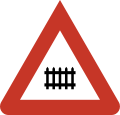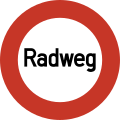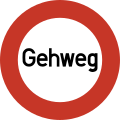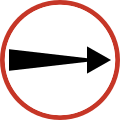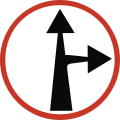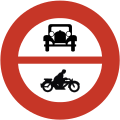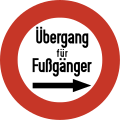Illustration of the traffic signs in the Soviet occupation zone and the German Democratic Republic from 1945 to 1956
The illustration of the traffic signs in the Soviet occupation zone and the German Democratic Republic from 1945 to 1956 shows the traffic signs in the Soviet occupation zone up to the ordinance of the first revision of the Road Traffic Regulations (StVO) in the German Democratic Republic (GDR) in 1956.
Until the complete occupation of Germany, the Road Traffic Regulations of 1937 with their amendments until 1944 remained valid, but shortly after the conquest of individual cities and regions the dismantling of the National Socialist symbols began. With the Control Council Act No. 2 passed on October 10, 1945 at the latest , the Allied Control Council announced the ban on the National Socialist German Workers' Party and its affiliated organizations. The ban also prohibited the use of the swastika . At the latest, the traffic sign Fig. 34a of the NSKK traffic assistance service issued in 1943 became invalid.
In principle, the StVO and the Road Traffic Licensing Regulations (StVZO) from 1937 continued unchanged except for the introduction of the GDR amendment to the StVO of February 6, 1953, which was not adopted in the Soviet sector of Berlin anyway, and was only changed with the new one Road traffic regulations of October 4, 1956 repealed. Instead of the amendment, from 1949 to 1956 some supplementary police regulations to the StVZO of 1937 were passed in the Soviet sector of Berlin. However, these had no influence on the traffic signs.
Very early on, the Soviet occupying power tried to maintain a steady flow of traffic, which was initially mainly intended to serve its immediate military operational capability. In this sense, among other things, the chief of the NKVD troops in Germany, Pawel Mikhailovich Simin and chief of staff Anatoly Volkov issued an order for their soldiers to exercise their service in Berlin on April 27, 1945. The border control posts had to make sure that no careless or improperly executed traffic signs were put up. Various photographs from the Soviet zone show, for example, motorway signs, which, carefully executed and adapted to German pre-war regulations, indicated near and long-distance destinations in Cyrillic and sometimes Latin letters.
Colours
Shortly after the founding of the GDR , there were considerations to break away from the German industrial norms and color standards that had previously been in force , as they had remained in force in the Federal Republic of Germany . Among other things, these measures aimed to underline the sovereignty and independence of the new state. Work on the new industry standardization became one of the country's major projects. The mass of old standards that had to be redefined, as well as the constantly changing requirements due to innovations in research and technology, made this work a Sisyphean work until the end of the German Democratic Republic . The new TGL system ( technical standards, quality regulations and delivery conditions ) was compared with the West German DIN standard for the first time in 1955 . It was not until the type color card 5/62, which appeared in 1962, that the first GDR-specific color standardization came into effect. Until then, the colors were based on the RAL color register 840 R, which was published in 1940, during the Second World War .
The following colors were specified in the 840 R color register for traffic signs. In brackets are today's color names that did not exist back then.
- Red: RAL 2002 (blood orange)
- Yellow: RAL 2007 (bright orange)
- Blue: RAL 5002 (ultramarine blue)
With the standardization of the enamel colors by the RAL from 1940, it became possible to give many traffic signs made of this type a uniform color.
When assessing the colors on the early traffic signs in East Germany, it is important that there were significant deviations from the pre-war requirements due to the shortage economy . Even the victorious powers , in this case the representatives of the Soviet Union in particular , only hinted at the RAL color scheme for newly commissioned signs.
typography
The typographical basis was the DIN 1451 standard sheet, first published in 1932 . As a recommendation in the Reichsgesetzblatt in 1937 it was stipulated that the fonts contained there should have a minimum line width of 7 millimeters. The numbers appearing on the traffic signs should be the height of the capital letters. Large letters were not less than 50 millimeters high and small letters not less than 35 millimeters high. Exceptions to these regulations have been set out on separate sample sheets.
Since typographic characters in particular were often still created by sign painters at that time, there could be significant deviations in the typeface and the expression of individual letters.
I. Warning signs
(Pictures 1 to 10)
II. Mandatory and prohibitive signs
(Pictures 11 to 31)
III. Notice signs
(Pictures 32 to 52)
Signs for lanterns that don't burn all night
(Pictures 35 to 36)
Place-name sign
(Pictures 37 to 38)
Instead of the administrative district, since the introduction of the StVO, which came into effect on January 1, 1938, the term “ customs border district ” could be used in the border areas . There was no separate picture for this in the regulation.
Signpost for Reichsstraßen (officially from 1953: trunk roads)
(Pictures 39 to 41)
Signpost for other paved roads
Signpost for unpaved roads
Reichsstrasse number plate (official from 1953: trunk road number plate)
Signs for ring roads or collecting roads for long-distance traffic
Pre-signpost
(Pictures 46 to 51)
Signs for major roads
IV. Sign for directing traffic in the event of road closures
(Pictures 53 to 58)
Signal discs on bogies for traffic control in case of half-sided closures
(Pictures 53 to 54)
Signpost for diversions
(Pictures 55 to 56)
Unnumbered characters, but also valid from January 1, 1938
Additional boards
Not listed in the StVO, but signs published in the Reichsverkehrsblatt
The following signs were published in the Reichsverkehrsblatt in 1939, but were not included in the road traffic regulations.
Example of a stop sign for motor vehicle lines of the Kraftpost . Kraftpost was dissolved in the GDR in 1953.
Guiding stones
The provisions of the provisional guidelines for the expansion of rural roads (RAL 1937) from December 1942 continued to apply in the GDR. They were only slightly modified in terms of text, as confirmed in the textbook Routing in Road Construction from March 1956. After that, the "guiding stones" should be made of light-colored and weather-resistant natural stone if possible. Concrete blocks should only be used in exceptional cases, for example if natural stones are missing or their freight costs are too high. The traffic safety measures established in 1942 continued to apply:
- 1. Guide stones and guide pegs,
- 2. Tree mirror,
- 3. Protective systems (railings and parapets),
- 4. Hyphens.
The dimensions of the stones and the color design also remained identical, although an illustration - as in 1942 - could be dispensed with.
Marks for crossings at rail height
These signs for crossings were not included in the road traffic regulations, but belonged to the railway building and operating regulations.
Warning crosses
hazard lights
Older warning lights that had not yet been dismantled
These signs did not belong to the railway building and operating regulations
StVO amendment 1953
In 1953, an ordinance promulgated on February 6, 1953 amending the ordinance on conduct in road traffic was published for the first time in the law gazette of the German Democratic Republic . This document was signed by the then Prime Minister Otto Grotewohl and the Chief of the German People's Police , Karl Maron , on behalf of the Ministry of the Interior. Until the fundamental revision of the StVO, which was published in 1956, the ordinance remained the only GDR amendment to the road traffic regulations of 1937. In the amendment of 1953, among other things, it was stipulated that users of main roads have the right of way. Main streets were:
- a) Long-distance traffic roads (including through town passages), identified by number plates (Annex I, Fig. 44 STVO) and the sign “Ring or collective roads for long-distance traffic” (Annex I, Fig. 45 STVO);
- b) Main roads, marked by a rectangle standing on its tip (Annex I, Fig. 52 STVO);
- c) also at individual crossings and junctions: streets where the triangles on the leading or intersecting streets “pay attention to the right of way on the main road” (Annex I, Fig. 30 STVO) or “stop, pay attention to the right of way on the main road! “(Annex I, Fig. 30 a STVO) are attached.
As a result of these changes, the word Reichsstraße was officially deleted from the StVO catalog and the word Fernverkehrsstraße used in the first road traffic regulations of the German Reich of 1934 was reintroduced. The amendment was not valid in the Soviet sector of Berlin.
Motorway signage
As a GDR study from 1988 noted, the new state inherited one of the “densest and best-developed road networks in the world” from the properties of the Third Reich . When it was founded in 1949, the German Democratic Republic had a total of 1,378 kilometers of Reichsautobahn with 904 bridges. Mostly German units had destroyed around 80 of these crossings in the last weeks of the war. The Soviet military government wanted to make these bridges passable with at least one lane as quickly as possible. However, further construction of the state's motorways was not on the planning list of the Railway, Transport and Liaison Department in the Central Committee of the Socialist Unity Party of Germany until 1958 . In addition to the few private vehicles, the increasingly decaying motorways were also used by cyclists and pedestrians with handcarts until well into the 1950s. This legally prohibited misappropriation often happened with the knowledge of the local people's police station. It was not until 1956 that some employees of the Roads Department in the Ministry of Transport drafted a “memorandum on the state of the road system in the GDR”, which called for the “immediate” renovation of roads and bridges. The road traffic regulations were applied analogously to the motorways.
Boards on the right edge of the road
Motorway exit announcement board on the AVUS in 1950
Boards at motorway filling stations
Web links
Remarks
- ^ Reichsgesetzblatt , year 1944, No. 56, date of issue: Berlin, February 4, 1944, p. 48.
- ↑ Ordinance amending the Ordinance on Conduct in Road Traffic. In: Reichsgesetzblatt , year 1943, No. 55, date of issue: Berlin, May 31, 1943, p. 334.
- ^ A b Siegfried Mampel : The Soviet Sector of Berlin. An analysis of its external and internal status . Metzger, Frankfurt a. M., Berlin 1963. pp. 315, 316.
- ↑ Law Gazette of the German Democratic Republic Part I, No. 103, Berlin, November 20, 1956, pp. 1239–1251; here: p. 1250.
- ^ Siegfried Mampel : The Soviet Sector of Berlin. An analysis of its external and internal status . Metzner, Frankfurt a. M. 1963, p. 316; a) Police Ordinance on the Requirements for Driving a Motor Vehicle from August 26 , 1949 ; b) Ordinance on the issuing of police license plates, on carrying out the technical inspection, on the registration of motor vehicles from motor vehicle trailers and on the conversion of motor vehicles of November 19 , 1953 , in addition : First implementing provision for this ordinance of November 19 , 1953 ; c) Ordinance amending the ordinance on the issuing of police license plates, on carrying out the technical inspection, on the registration of motor vehicles and vehicle trailers and on the conversion of motor vehicles of 31.3.1955 ; d) Announcement on the registration of motorcycles (mopeds) and the issuance of a driving license from 03/15/1956 ; only the regulations under b) and c) followed the models from the Soviet occupation zone and the GDR.
- ↑ Directive of the staff of the NKVD troops for the protection of the hinterland of the 1st Belarusian Front, No. Sch / 1-001083 on the order of the exercise of service in Berlin , April 27, 1945
- ↑ Johannes Denecke: Lackfarben 1932-1945. In: Johannes Denecke Camouflage paints of the German army 1914 to today , Bernard & Graefe, Bonn 1999, ISBN 3-7637-5990-5 . Pp. 104-106.
- ↑ Commercial legal protection and copyright. Verlag Chemie, Weinheim an der Bergstrasse 1958, p. 444.
- ^ Reichsgesetzblatt , year 1937, No. 56, date of issue: Berlin, November 16, 1937, p. 1195.
- ↑ a b c d Reichsgesetzblatt , year 1937, No. 56, date of issue: Berlin, November 16, 1937, p. 1192.
- ↑ a b c Reichsgesetzblatt , year 1937, No. 56, date of issue: Berlin, November 16, 1937, p. 1193.
- ^ Ordinance on behavior in road traffic (Road Traffic Regulations - StVO -) of November 13, 1937 . In: Reichsgesetzblatt , Part 1, year 1937, No. 56, Berlin, November 16, 1937, p. 1193.
- ^ Reichsverkehrsblatt B, No. 33 of July 29, 1939
- ↑ Volkhard Stern: 100 years of Kraftpost . In: The archive. Magazin für Post- und Telekommunikationsgeschichte 1 (2005), p. 16 ff .; here: p. 18.
- ^ Erwin Fuchs: Lines in road construction , Fachbuchverlag Leipzig, Leipzig 1956, p. 139.
- ↑ Ordinance amending the Ordinance on Conduct in Road Traffic - Road Traffic Regulations - (STVO) . In: Law Gazette of the German Democratic Republic 19, issue date: February 13, 1953, p. 269.
- ↑ Axel Doßmann: Auto-Suggestions. For motorway planning in the GDR until 1961 . In: Burghard Ciesla, Axel Doßmann, Barbara Schmucki, Thomas Zeller u. a .: Netzwerk Autobahn (= Werkstatt Geschichte 21), Klartext, Essen 1998, ISBN 3-87916-230-1 , pp. 65–85; here: p. 66.
- ↑ Axel Doßmann: Auto-Suggestions. For motorway planning in the GDR until 1961 . In: Burghard Ciesla, Axel Doßmann, Barbara Schmucki, Thomas Zeller u. a .: Netzwerk Autobahn (= Werkstatt Geschichte 21), Klartext, Essen 1998, ISBN 3-87916-230-1 , pp. 65–85; here: p. 65.
- ↑ Axel Doßmann: Auto-Suggestions. For motorway planning in the GDR until 1961 . In: Burghard Ciesla, Axel Doßmann, Barbara Schmucki, Thomas Zeller u. a .: Netzwerk Autobahn (= Werkstatt Geschichte 21), Klartext, Essen 1998, ISBN 3-87916-230-1 , pp. 65–85; here: p. 68.
- ^ Friedrich Nöhring: Der Strassenbaupraktiker , Fachbuchverlag, Leipzig 1953, p. 78.









